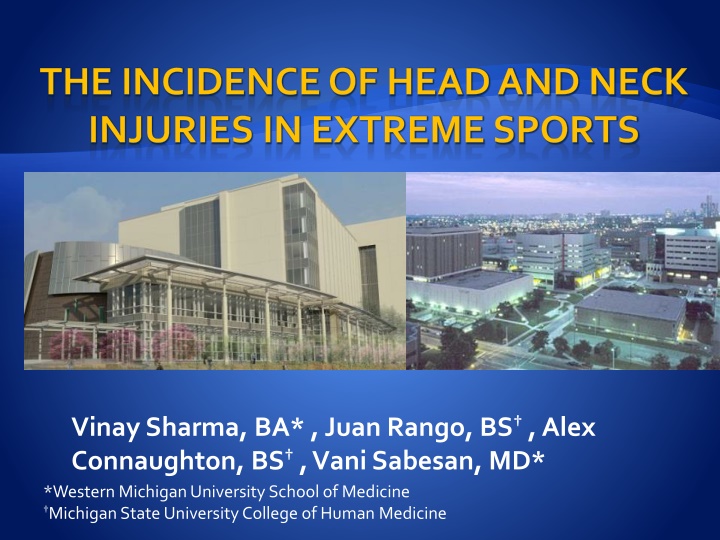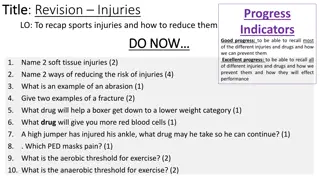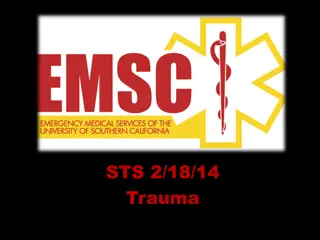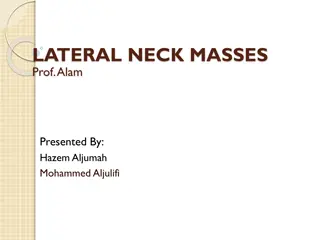The Incidence of Head and Neck Injuries in Extreme Sports
Study on the prevalence of head and neck injuries in extreme sports, specifically focusing on concussions, a common type of brain injury. The research highlights the impact and risks associated with extreme sports activities, showcasing data on traumatic brain injuries and non-fatal incidents related to sports and recreation. The report emphasizes the vulnerability of children and adolescents to concussions, urging for increased awareness and safety measures in extreme sports.
Download Presentation

Please find below an Image/Link to download the presentation.
The content on the website is provided AS IS for your information and personal use only. It may not be sold, licensed, or shared on other websites without obtaining consent from the author.If you encounter any issues during the download, it is possible that the publisher has removed the file from their server.
You are allowed to download the files provided on this website for personal or commercial use, subject to the condition that they are used lawfully. All files are the property of their respective owners.
The content on the website is provided AS IS for your information and personal use only. It may not be sold, licensed, or shared on other websites without obtaining consent from the author.
E N D
Presentation Transcript
THE INCIDENCE OF HEAD AND NECK INJURIES IN EXTREME SPORTS Vinay Sharma, BA* , Juan Rango, BS , Alex Connaughton, BS , Vani Sabesan, MD* *Western Michigan University School of Medicine Michigan State University College of Human Medicine
Disclosures No outside sources of funding were used for this study No conflicts of interest to report
What is a Concussion a complex pathophysiological process that affects the brain, typically induced by trauma Caused either by a direct blow to the head or an indirect blow to the body neurological impairments that may resolve spontaneously Symptoms usually reflect a functional disturbance to the brain, and may include symptoms: physical (e.g., headaches, nausea) cognitive (e.g., difficulty with concentration or memory) emotional (e.g., irritability, sadness) maintenance' (e.g., sleep disturbances, changes in appetite or energy levels) A concussion is considered a brain injury.
Concussions Each year, U.S. emergency departments (EDs) treat an estimated 173,285 sports- and recreation-related traumatic brain injuries, including concussions Children from birth to 19 years of age Children and teens are more likely to get a concussion and take longer to recover than adults. Nonfatal Traumatic Brain Injuries Related to Sports and Recreation Activities Among Persons Aged 19 Years --- United States, 2001 2009 Morbidity and Mortality Weekly Report (MMWR) October 7, 2011 / 60(39);1337-1342
Estimated TBI vs. non-fatal injuries All visits for sports and recreation--related injuries % of all visits for injuries that were TBIs TBIs Activity No.* 26,212 No.* 323,571 8.1 5.9 Bicycling Skateboarding Moped/Dirt bike 6,004 101,577 8.6 3,370 39,363 riding Roller skating/ Unspecified skating 3.2 1,126 34,717 3.4 6.5 In-line skating 853 25,350 Total 173,285 2,651,581 http://www.cdc.gov/mmwr/preview/mmwrhtml/mm6039a1.htm?s_cid=mm6039a1_w#tab1
Extreme Sports What are extreme sports? non-traditional, adventure sports high-risk activities with the potential for serious injury and danger, including the risk of a fatal injury. evolved to denote activities such as bungee jumping, snowboarding, extreme skiing, canyoning, surfing, skateboarding, sky- diving, paragliding, rock climbing and mountain bicycling
Extreme Sports Since the mid 1960s, international participation has grown exponentially, especially among teenagers Accepted as a separate and organized entity as evidenced by the advent and rising popularity of the X-games Winter Olympics in 2014
Extreme Sports Despite heightened participation little evidence exists describing injury rates due to: non-traditional independent participation lack of official regulation Increased risk of injury and death necessitates the need to better understand injury rates and trends Specifically, head and neck injuries (HNI) are a growing concern because of increased awareness of short and long term consequences reported in the literature
Media and Concussions First White House Healthy Kids & Safe Sports Concussion Summit May 29, 2014 - President Obama said: We need 'better data' on sports concussions We've got to have better research, better data, better safety equipment, better protocols." http://www.usatoday.com/story/news/2014/05/29/obama-concussions-football-soccer-healthy-kids-- safe-sports-concussion-summit/9716717/
PURPOSE Describe the epidemiology of head and neck injuries in participants of seven extreme sports from 2000 to 2011.
METHODS The Consumer Product Safety Commission s (CPSC) National Electronic Injury Surveillance System (NEISS) was used HNIs associated with 7 extreme sports were examined using the NEISS consumer product codes Sport Participation figures were obtained using The Outdoor Foundation annual participation report Incidence rates and incidence rate ratios were calculated from 2007 to 2012 (excluding motocross which lacked available data)
METHODS HEAD INJURIES TYPES OF SPORTS Concussion Contusions/Abrasions Fractures Lacerations Skateboarding Mountain Biking Motocross Surfing Snowboarding Snow skiing Snowmobiling NECK INJURIES Strain/sprains Contusions/Abrasions Fractures Lacerations
RESULTS 4,083,691 total injuries reported for all seven extreme sports 460,115 (11.3%) were head and neck injuries 381,760 (83%) were head injuries 78,355 (17%) were neck injuries The risk of an extreme sport participant suffering a HNI over a one-year period was 5.16 per 10,000 person-years
RESULTS The four sports with the highest total number of reported HNI injuries were: skateboarding (129,600) snowboarding (97,527) skiing (83,313) motocross (78,236) 1. 2. 3. 4.
RESULTS 140,650 concussions (31% of HNI, 3.4% of all injuries) Incidence rate* Incidence Rate Ratio Sport Mountain Biking 50 1.00 Snowmobiling 60 1.20 Surfing 103 2.06 Snow Skiing 152 3.04 Skateboarding 415 8.30 Snowboarding 534 10.68
RESULTS Skull Fractures Incidence Rate (1,000,000 person-years) 1 2 2 4 9 55 Sport Snowboarding Mountain Biking Snow Skiing Snowmobiling Surfing Skateboarding Neck Fractures Incidence Rate (1,000,000 person-years) 1 5 6 7 13 38 Sport Skateboarding Snow Skiing Snowmobiling Snowboarding Mountain Biking Surfing
Conclusions This study establishes incidence rates of HNI in exteme sports Over 12 yrs, 4million injuries occurred, 11.3% (460,115) were HNI Concussions were the most common HNI among extreme sports participants Highest risk in snowboarding and skateboarding participation
Conclusions Risk for TBI is inherent to physical activity and can occur during any activity at any age. Minimize risk by: 1) using protective equipment that is appropriate for the activity, fits correctly, is well maintained 2) coaching appropriate sport-specific skills with an emphasis on safe practices and proper technique; 3) adhering to rules of play with good sportsmanship and strict officiating
Conclusions Secondary prevention strategies include increasing awareness of the signs and symptoms of TBI and recognizing and responding quickly and appropriately to suspected TBI.
Conclusions Participants suspected of having a TBI should: be removed from play never returned to play the same day allowed to return only after evaluation and clearance by a health-care provider who is experienced in diagnosing and managing TBI
Conclusions Return to play is a critical decision because children and adolescents are at increased risk for: repeat concussion during sports and recreation activities long-term sequelae delayed recovery cumulative consequences of multiple TBIs (e.g., increased severity of future TBIs and increased risk for depression and dementia)
ABC News Extreme sport competitions such as the X Games and Core Tour were born out of athletes who live and breathe doing flips on snowmobiles, landing 1,080-degree turns on skis and BASE-jumping off 2,000-foot cliffs. But even the best daredevils have suffered unimaginable injuries, some fatal, doing what they love Caleb Moore-Snowmobiler Jeb Corliss-Base Jumper Sarah Burke- Freestyle Skier Kevin Pearve- Snowboarder Mat the condor Hoffman- BMX Rider Stephan Murray- BMX Dirt Rider John Kucera- Downhill Ski Champion Bethany Hamilton- Surf Champ Jeremy Lusk- Freestyle Moto X Star
Conclusion The recent death of extreme snowmobiler Caleb Moore at the 2013 Winter X games demonstrated the serious risks associated with these sports. HNI can greatly alter a person s quality of life, and as participation in these sports increases, a well- established understanding of the incidence of HNI will assist in implementing effective medical prevention programs and proper safety equipment practices.
Thanks to: Our research team, Vinay Sharma, Juan Rango, and Abby Childs























